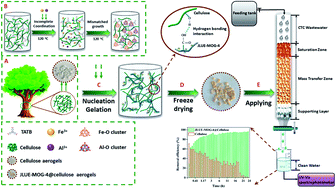Stable cellulose-based porous binary metal–organic gels as highly efficient adsorbents and their application in an adsorption bed for chlortetracycline hydrochloride decontamination†
Abstract
To exploit adsorbents for removing refractory pollutants from aquatic environments, three novel bimetallic MOGs, JLUE-MOG-3, JLUE-MOG-4 and JLUE-MOG-5, with diverse large surface areas that could be controlled by varying the content of Fe or Al ions, were synthesized by a solvothermal method for chlortetracycline hydrochloride (CTC) capture. The obtained JLUE-MOG aerogels, with strong chemical and mechanical stability, showed strong CTC adsorption capacities as high as 1841.62, 1600.00 and 1396.65 mg g−1 at 25 °C, respectively, according to the Langmuir model. Beyond the porousness and electrostatic interactions, hydrogen-bonding interactions, water affinity and π–π interactions may also combine to contribute to the superb CTC removal. Furthermore, the interactions between influencing factors and the optimized experimental conditions were simulated by response surface methodology (RSM). Moreover, in order to enhance the practicability, cellulose aerogels were introduced as 3D porous support skeletons for the in situ growth of JLUE-MOG-4. As immobilized adsorbents, JLUE-MOG-4@cellulose composite aerogels exhibited a CTC removal efficiency of >95.00% during sustained 24 h operation in a custom-made adsorption bed. This work provides an in situ growth strategy for bringing MOGs into practical water remediation applications, with stable, efficient, processable and environmentally friendly features.



 Please wait while we load your content...
Please wait while we load your content...